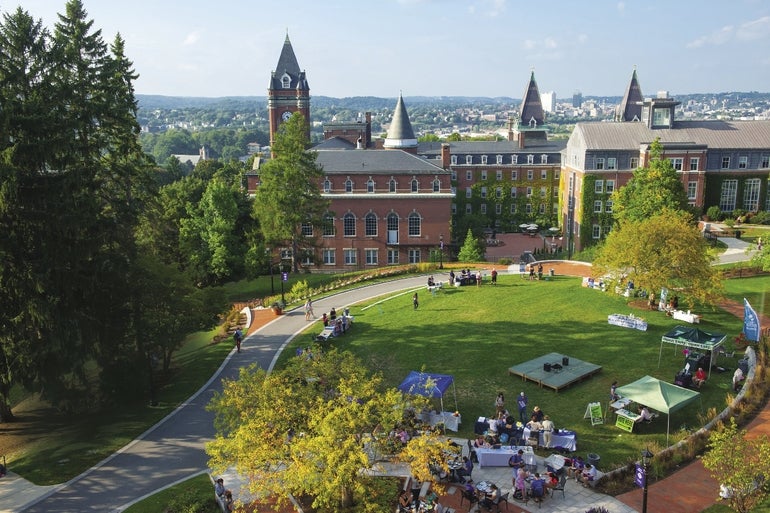Worcester is peppered with renowned colleges and universities, but from an aesthetics standpoint, the College of the Holy Cross is the reigning crown jewel.
With its historic buildings carved into a sloping landscape and panoramic views of the city, Holy Cross was singled out in March by Travel + Leisure magazine, which named the campus the “Most Beautiful in Massachusetts” – no small feat given the roster of quintessential New England campuses that call the Bay State home. Holy Cross added the accolade to a list of recent awards recognizing the undergraduate Jesuit school for its grounds.
The praise is the result of painstaking efforts to give potential students a strong first impression when touring the school, providing an escape full of lush greenery in an urban environment while still maintaining Holy Cross’ historic flair.
Advantage: Steep hills
For the last eight years, Ted Heywood has been the mastermind behind the college’s coiffed grounds. As superintendent of grounds, Heywood manages a staff of 15 full-time employees, as well as several seasonal and student workers, depending on the time of year.
Recognizing the competition, Heywood said being named Travel + Leisure’s most beautiful Massachusetts campus is an honor.
While mowing and trimming the steep hills is arduous, the slopes are probably the school’s greatest visual assets. On flatter campuses, buildings and landscapes are experienced one at a time, Heywood said, but spectators can take it all in on the staggered Holy Cross campus.
“The school is a visual display,” Heywood said.
Blending old and new
Dating back to 1843, the College of the Holy Cross spans roughly 170 acres, with about 15 of them wooded. In all of the grounds work, Heywood is constantly balancing respect for historic beauty with plans for enhancements, always with an eye on the interplay between architecture and the land.
Recent updates include the resodding of Fitton Field in 2016. It was the first time the field was resodded since it was built in 1903, and the project included a new irrigation system, boosting the Holy Cross football program, Heywood said.
A rooftop garden was also added to the Dinand Library in 2016, and the college’s Hogan Oval, a popular outdoor gathering site, was renovated in 2011, replacing a turf walkway area with a new lawn and pedestrian-only walkways.
First impressions
Heywood believes all this painstaking work sends a simple message to prospective students, and their parents.
“If we can take care of the flowers and shrubs and trees, we can do a good job with the students we have,” Heywood said.
Lynn Verrecchia, senior associate director of admissions at Holy Cross, agreed first impressions are very important to students and their parents as they tour the campus.
The beauty of the surroundings immediately puts students at ease, said Verrecchia, who graduated from Holy Cross in 2001. While perhaps not a deciding factor, the landscape creates a captive audience.
“You need more than a pretty tree,” Verrecchia said, “but I think it starts that conversation.”
Verrecchia said students expect to see rolling hills and lush greenery at more rural campuses, such as Mount Holyoke College in South Hadley and Williams College in Williamstown, but it’s somewhat startling in an urban environment.
“I do think that some of what adds to it is that it’s a little unexpected,” Verrecchia said.
The campus experience
Rob Franek, editor-in-chief at The Princeton Review, is a little reserved about rankings and accolades unless he knows the methodology behind them, (The Princeton Review bases its famous rankings lists on student feedback, he noted) but he said being named most beautiful campus is an honor to tout.
Franek spends much of his time talking with students and parents about their college admissions decisions, and there’s no doubt that students often have a visceral reaction to a campus.
Academic fit will always be the most important factor to prospective students, but Franek said campus experience follows closely behind.
“What is going to be your experience outside the classroom?” Franek said.
Sustaining the environment
Environmental considerations are important, Heywood said. Because Holy Cross is a steward of a number of historic trees, including one planted by President Theodore Roosevelt, so the college takes great care in tree management practices.
The greatest looming threat this year is the potential for gypsy moth infestation, said Heywood; the wet spring may have laid conditions for a bad year, though the gypsy moths won’t hatch until later in the spring. Meanwhile, the grounds staff is considering how to spare vulnerable trees with the judicious use of pesticides. White pine and hemlock trees can be killed by one infestation, Heywood said.
Last year’s drought was another force of nature to reckon with. The college had to adjust the watering schedule under city water bans last summer, and irrigation heads were renozzled to make watering more efficient.

